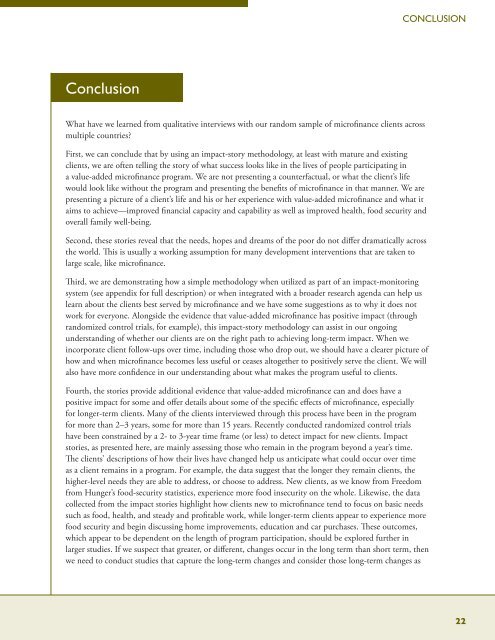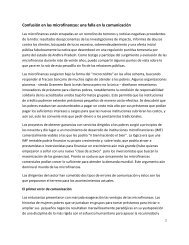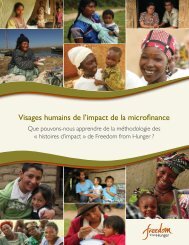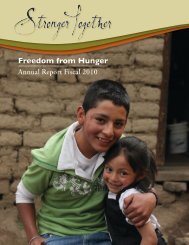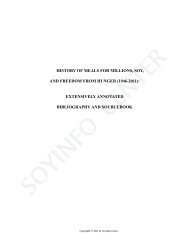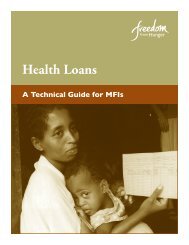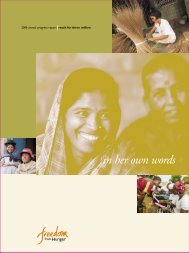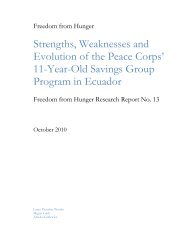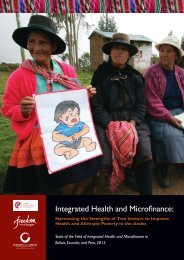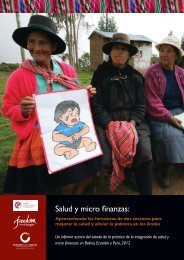English - Freedom from Hunger
English - Freedom from Hunger
English - Freedom from Hunger
You also want an ePaper? Increase the reach of your titles
YUMPU automatically turns print PDFs into web optimized ePapers that Google loves.
Conclusion<br />
What have we learned <strong>from</strong> qualitative interviews with our random sample of microfinance clients across<br />
multiple countries?<br />
First, we can conclude that by using an impact-story methodology, at least with mature and existing<br />
clients, we are often telling the story of what success looks like in the lives of people participating in<br />
a value-added microfinance program. We are not presenting a counterfactual, or what the client’s life<br />
would look like without the program and presenting the benefits of microfinance in that manner. We are<br />
presenting a picture of a client’s life and his or her experience with value-added microfinance and what it<br />
aims to achieve—improved financial capacity and capability as well as improved health, food security and<br />
overall family well-being.<br />
Second, these stories reveal that the needs, hopes and dreams of the poor do not differ dramatically across<br />
the world. This is usually a working assumption for many development interventions that are taken to<br />
large scale, like microfinance.<br />
Third, we are demonstrating how a simple methodology when utilized as part of an impact-monitoring<br />
system (see appendix for full description) or when integrated with a broader research agenda can help us<br />
learn about the clients best served by microfinance and we have some suggestions as to why it does not<br />
work for everyone. Alongside the evidence that value-added microfinance has positive impact (through<br />
randomized control trials, for example), this impact-story methodology can assist in our ongoing<br />
understanding of whether our clients are on the right path to achieving long-term impact. When we<br />
incorporate client follow-ups over time, including those who drop out, we should have a clearer picture of<br />
how and when microfinance becomes less useful or ceases altogether to positively serve the client. We will<br />
also have more confidence in our understanding about what makes the program useful to clients.<br />
Fourth, the stories provide additional evidence that value-added microfinance can and does have a<br />
positive impact for some and offer details about some of the specific effects of microfinance, especially<br />
for longer-term clients. Many of the clients interviewed through this process have been in the program<br />
for more than 2–3 years, some for more than 15 years. Recently conducted randomized control trials<br />
have been constrained by a 2- to 3-year time frame (or less) to detect impact for new clients. Impact<br />
stories, as presented here, are mainly assessing those who remain in the program beyond a year’s time.<br />
The clients’ descriptions of how their lives have changed help us anticipate what could occur over time<br />
as a client remains in a program. For example, the data suggest that the longer they remain clients, the<br />
higher-level needs they are able to address, or choose to address. New clients, as we know <strong>from</strong> <strong>Freedom</strong><br />
<strong>from</strong> <strong>Hunger</strong>’s food-security statistics, experience more food insecurity on the whole. Likewise, the data<br />
collected <strong>from</strong> the impact stories highlight how clients new to microfinance tend to focus on basic needs<br />
such as food, health, and steady and profitable work, while longer-term clients appear to experience more<br />
food security and begin discussing home improvements, education and car purchases. These outcomes,<br />
which appear to be dependent on the length of program participation, should be explored further in<br />
larger studies. If we suspect that greater, or different, changes occur in the long term than short term, then<br />
we need to conduct studies that capture the long-term changes and consider those long-term changes as<br />
ConClusIon<br />
22


